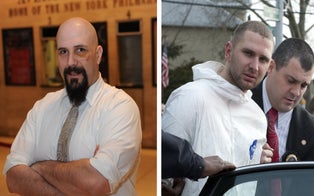Katelyn Davis killed herself live online in Dec. 2016, less than a month later, 14-year-old Nakia Venant did the same.
In 2008, 19-year-old Abraham Biggs overdosed on prescription drugs — and live streamed it on an internet forum.
While he was one of the first to broadcast his own death online, he wouldn’t be the last.
Read: Parents Sue School After Teen Killed Himself When Confronted About Sex Video
Eight years later, 12-year-old Katelyn Nicole Davis, of Georgia, hanged herself from a tree. A video of her death streamed on Live.me for more than 40 minutes before it cut out. She had regularly shared her feelings of depression and hopelessness on the site prior to taking her life in December 2016.
The following month, 14-year-old Nakia Venant used a scarf to hang herself in the bathroom of her Florida foster home while streaming live on Facebook. The video was two hours long.
Suicide is the second leading cause of death for youth aged 15 to 24. With this generation of young people living out much of their lives online, it is perhaps unsurprising that they’re using social media to express their darkest thoughts — and share their darkest moments.
“Before smartphones existed and people were really struggling with [suicidal] thoughts, if they expressed it at all, they expressed it in notes to their peers or they expressed it in their entire conversations, but today those are not the way that kids communicate,” Daniel Reidenberg, executive director of SAVE (Suicide Awareness Voices of Education), an organization dedicated to the prevention of suicide, told InsideEdition.com.
Biggs, a student at Broward County College, often spoke about his depression on Bodybuilding.com.
“He grew up with a computer — he loved it," Doreen Facey-Biggs, Biggs’ mother, told InsideEdition.com. "He worked in the media center at school. That was his life.”
He eventually published his suicide note on the Bodybuilding.com forum using the screenname “CandyJunkie.”
"I hate myself and I hate living,” he wrote in the note, according to ABCNews. "I have let everyone down and I feel as though I will never change or never improve... I have thought about and attempted suicide many times in the past.”
Facey-Biggs said she knew her son struggled with depression. She confirmed he had attempted suicide months before his death and had been diagnosed as bipolar. She said she’d taken Biggs to multiple psychiatrists, who’d prescribed him medication, but he was still struggling and said that he didn’t like the way the medication made him feel.
Facey-Biggs said her son had a hard time talking to her about his feelings and instead posted about his emotions online. According to reports, he had threatened suicide on the bodybuilding forum before.
“I think he was using those sites to reach out to people who could relate to what he was going through,” Rosalind Biggs, Biggs’ older sister, told InsideEdition.com.
But Rosalind said there was also a dark side to the forums that they weren’t aware of while Abraham was still alive.
“There’s this pattern of abuse that went on in this miscellaneous section of the bodybuilding forum,” she said. “All the trolls were in that section. It was very unbalanced.”
That dark side was made even clearer when he told other users he was taking his life.
In November 2008, 12 hours before police found him dead in his father’s Florida home, Biggs again began posting about his plans to kill himself. The teen then shared a link on Bodybuilding.com to Justin.tv, a site that allowed users to broadcast live videos from their webcams.
With the camera running, Biggs took a deadly cocktail of benzodiazepines and opiates.
"On one of the sites, Justin.tv, he said something like, ‘Guess who just overdosed,’” said Wendy Crane, an investigator at the Broward County Medical Examiner's office, which investigated his death. “It doesn’t immediately click with everyone and then people start saying, ‘Yeah, right’ like they don’t believe him.”
Crane said Biggs eventually laid down with his back to the camera. Viewers started to comment that they could see him breathing.
“They were talking about it like it was immaterial,” she said. “Then some people start saying he hasn’t moved in a while.”
Biggs’ mother said she talked to him early on Nov. 19, not realizing he had already taken some of the pills. She recalled that he was calm and when she asked him if he needed her to come to the house, he said, “No, I don’t want you to come.’”
By 3:30 p.m., Biggs was dead. Police responded to the Pembroke Pines home after a 7-year-old boy, who had seen the livestream from India, told his father to call police, the Biggs family said.
It is not clear how many other people watched his suicide.
On the livestream, cops were seen busting down Biggs’ door as he lay on his dad’s bed, according to multiple reports.
Read: '13 Reasons Why' Blasted by Schools for Glamorizing Teen Suicide
As police entered the room, the commenters on Justin.tv reacted differently. Some wrote, "Oh my God.” Others wrote, "lol," or "laugh out loud," and "hahahah,” according to CBSNews.com.
“He was crying out for help symbolically and was met with ridicule and disbelief,” Crane said. “You never know who you are talking to online and if they are doing what they are saying. It is unfortunate because you never know if someone had contacted the authorities in time if they could have saved him.”
Justin.tv, which no longer exists, released a statement after Biggs’ death saying, "We regret that this has occurred and want to respect the privacy of the broadcaster and his family during this time."
Bodybuilding.com, where Biggs regularly shared his suicidal thoughts, did not respond to requests for comment.
His sister said she believes no one helped because some didn’t believe it was real and because people are overexposed to negativity, especially online. Reports say that some users did try to talk Biggs out of it, however.
“I think it’s a sense of apathy,” Rosalind Biggs said. “People aren’t connecting with an experience unless they see themselves in it. If it’s a random person and they can disconnect from it, they will, just as a face-guard.”
Her mother has also tried to make sense of why people watched the suicide but failed to help.
“I have watched it. Not the entire video, just what everyone else saw. When he lays there and the cops break down the door,” Facey-Biggs said. “At first I was hurt. I was disappointed in people. I could not believe how nasty people were. It’s like a train wreck. You can’t stop watching. You should do something about it, but you can’t stop watching."
Experts say that when people view violent or suicidal acts online and don’t do anything about it, it can be compared to the bystander effect, a social psychological phenomenon in which individuals are less likely to offer help to a victim when other people are present.
“One of the things we have found in our research is [people’s] networks are somewhat exaggerated online, like 1,500 friends or followers. I think the bystander effect is what you are sometimes seeing in these suicides,” said Kaveri Subrahmanyam, associate director at the Children's Digital Media Center at Los Angeles. “There is psychological distance between you and the screen. People watching don’t think they are the only one.”
Although the CDC does not have data on the number of people who have taken their lives while on social media, experts say incidents are likely to increase.
“Today’s young people, live their lives [online] very early on. That’s where they learn things. That’s where they engage with the people in their lives and that is their community,” said Reidenberg, the executive director of SAVE. “Sadly, I think we are going to see more of this until we have better systems within technology and more research into understanding how and why this happens.
“When young people are putting all of their thoughts, all of their feelings, all of the things that they are doing online, it shouldn’t be any surprise to anyone that when they are struggling, that they put that out there too.”
Read: Suicide Notes of Mom Who Killed Kids and Herself Revealed: 'I Hope You Rot'
As instances of online suicide increase, major sites that have been touched by the trend, like Facebook, are creating strategies to help those who may be experiencing a mental health crisis.
Mark Zuckerberg, the co-founder of Facebook, released a statement about streaming self-harm and violent attacks in May after Steve Stephens posted a video of himself shooting an elderly stranger in Cleveland. A month earlier, 49-year-old James M. Jeffrey of Alabama, fatally shot himself on Facebook Live and a Thai man filmed himself killing his 11-month-old daughter in two clips he posted to the social networking site.
“Over the last few weeks, we've seen people hurting themselves and others on Facebook — either live or in video posted later," Zuckerberg wrote in Facebook post on May 3. "It's heartbreaking, and I've been reflecting on how we can do better for our community."
Facebook announced they would add 3,000 employees over the next year to help review millions of videos and posts reported by users.
“We're working to make these videos easier to report so we can take the right action sooner — whether that's responding quickly when someone needs help or taking a post down,” Zuckerberg said.
The social network said it’s also integrating suicide prevention tools to help people during Facebook Live, live chat support from crisis support organizations through Messenger and streamlined reporting for suicide, assisted by artificial intelligence.
Dr. Sally Nazari, a New York psychologist who specializes in cases of depression, said monitoring starts at home. Families need to be aware of the signs that a teen may be depressed or suicidal, she said.
“Often, we see a teen who's contemplating suicide start to pull away from the things that have been meaningful in their life," Nazari said. "Anything like friends, hobbies, responsibilities and commitments. If we see our teens acting in ways that don't really make sense for the context in their lives, it's important for us to notice their activities.”
When it comes to their lives online, Nazari said family and friends should also look for a change in behavior.
Read: Man Proposes to Woman 10 Years After She Interrupted His Suicide: 'Thanks for Saving My Life'
“What we might see is a greater amount of screen time or secrecy or defensiveness about the screen time,” Nazari said. “If we start seeing an increasing number of posts and pictures, showing they're taking a lot of risks, or we start seeing hashtags related to death or risky behavior, it might be time for us to check in and see what's going on.”
For Biggs, however, the help came too late. His family said they wish others — those seeing his posts online and, eventually, those watching his suicide — had spoken up sooner.
“When something happens to somebody else, and we see it, we hope that someone [else] can do something because we’re working on 'XYZ,'” Rosalind Biggs said. “There is a disconnect to the human experience because there’s so many other things that are pulling at us.”
Watch: 11-Year-Old Kills Himself After Thinking Girlfriend Committed Suicide: Cops





